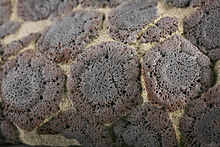Scute

A scute or scutum (Latin scutum, plural: scuta "shield") is a horny external plate or scale, as on the shell of a turtle, the skin of crocodilians, the feet of some birds or the anterior portion of the mesonotum in insects.
Properties


Scutes are similar to scales and serve the same function. Unlike the scales of lizards and snakes, which are formed from the epidermis, scutes are formed in the lower vascular layer of the skin and the epidermal element is only the top surface. Forming in the living dermis, the scutes produce a horny outer layer that is superficially similar to that of scales. Scutes will usually not overlap as snake scales (but see the pangolin). The outer keratin layer is shed piecemeal, and not in one continuous layer of skin as seen in snakes or lizards. The dermal base may contain bone and produce dermal armour. Scutes with a bony base are properly called osteoderms. Dermal scutes are also found in the feet of birds and tails of some mammals, and are believed to be the primitive form of dermal armour in reptiles.
The term is also used to describe the heavy armour of the armadillo and the extinct Glyptodon, and is occasionally used as an alternative to scales in describing snakes or certain fishes, such as sturgeons, shad, herring, and menhaden.
Turtles
The turtle's shell is covered by scutes formed mostly of keratin. They are built similarly to horn, beak, or nail in other species. See the main article on the Turtle shell.
Insects
The term "scutum" is also used in insect anatomy, as an alternative name for the anterior portion of the mesonotum (and, technically, the metanotum, though rarely applied in that context).
